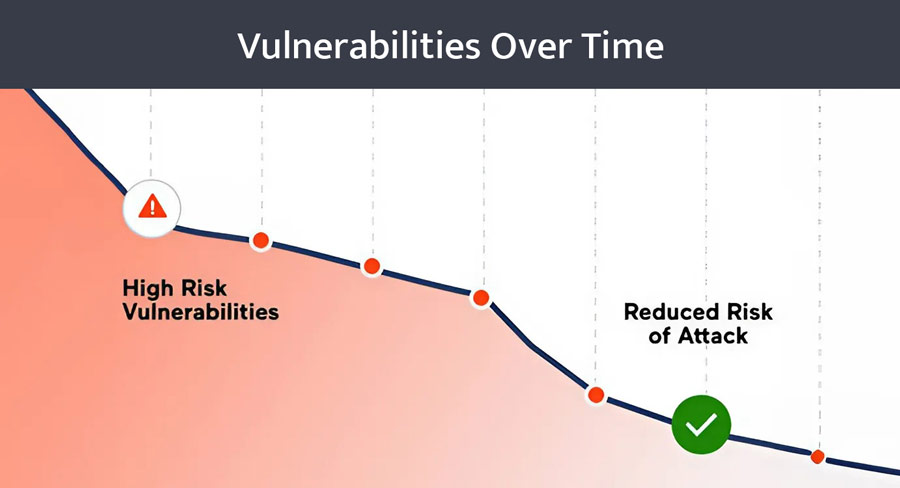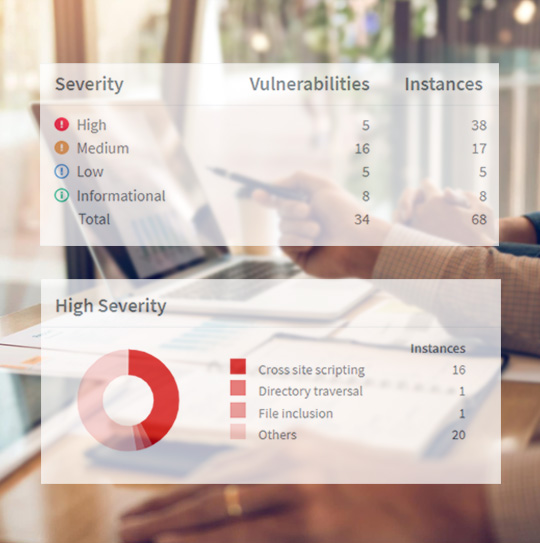Web Application Vulnerability Scanning
Table of Contents
Why Web Application Security Matters
The internet has become interwoven into the fabric of our lives. We rely on web applications for everything from managing our finances to connecting with loved ones. Online banking, social media platforms, and e-commerce websites store and transmit sensitive information, making them prime targets for malicious actors.
These applications are constantly under attack from cybercriminals seeking to exploit vulnerabilities in their code. These vulnerabilities can take many forms, such as weaknesses in authentication protocols that allow unauthorized access, or flaws in data handling that make it susceptible to theft.
The Open Web Application Security Project (OWASP) publishes a yearly report highlighting the top ten web application security risks (https://owasp.org/www-project-top-ten/) that can pose a significant threat to organizations of all sizes. A data breach can have devastating consequences, leading to financial losses, reputational damage, and even legal repercussions.
Just like a homeowner wouldn’t wait for a break-in before installing a security system, organizations shouldn’t wait for a cyberattack before addressing web application security. Proactive measures are essential to identify and address these vulnerabilities before attackers can exploit them. This is where web application vulnerability scanning comes in.
What is Web Application Vulnerability Scanning?
Imagine your web application as a digital fortress safeguarding sensitive data. Just like a vigilant guard wouldn’t wait for an intruder before securing the castle, you shouldn’t wait for a cyberattack before fortifying your application’s defenses. Web application vulnerability scanning is your automated security guard, constantly on patrol to identify weaknesses that attackers might exploit.
In simpler terms, it’s an automated process that meticulously examines your web application for potential security gaps. Think of it like a digital security inspection, where a sophisticated tool meticulously scans your application, searching for vulnerabilities like insecure login procedures, hidden pathways for unauthorized access, or flaws in how the application handles data.
Vulnerability scanners employ various techniques to simulate real-world attack methods. This might involve testing how the application reacts to different user inputs, probing for weaknesses in authentication systems, or analyzing the application’s code itself for potential security loopholes.
The key here is that vulnerability scanners don’t attempt to breach your application – they act more like ethical hackers, identifying vulnerabilities that could be exploited if left unaddressed. By proactively uncovering these weaknesses, you can take steps to patch them up and significantly bolster your web application’s security posture.
Benefits of Vulnerability Scanning
Web application vulnerability scanning offers a technical advantage by providing a proactive and multi-faceted approach to security. Acunetix, a leading web application security scanner, exemplifies this approach. Let’s explore some key benefits in more depth:

1. Identifying Vulnerabilities Across Different Attack Vectors:
Modern vulnerability scanners, like Acunetix, go beyond basic web application attacks. They employ a combination of techniques to uncover a wide range of vulnerabilities:
1. Dynamic Application Security Testing (DAST):
Imagine a security guard testing your castle’s defenses. DAST works similarly, simulating real-world attacks to uncover vulnerabilities in your web application’s functionality. Here’s how it operates:
Malicious Payload Injection: DAST injects specially crafted code snippets (payloads) into various parts of your application, mimicking techniques hackers might use. These payloads can be designed to test for vulnerabilities like SQL injection (manipulating database queries) or Cross-Site Scripting (XSS) (injecting malicious scripts into seemingly harmless web pages).
Fuzzing Techniques: DAST employs fuzzing, where it bombards your application with unexpected or invalid inputs (like nonsensical characters or large data packets). This can reveal vulnerabilities in how your application handles unexpected data, potentially leading to crashes or unauthorized access.
Focus on Exploitable Vulnerabilities: DAST excels at identifying vulnerabilities that attackers can actively exploit. By mimicking real-world attack methods, DAST prioritizes vulnerabilities with a higher chance of being used in a cyberattack.
2. Static Application Security Testing (SAST)
Think of SAST as a code auditor meticulously examining your application’s blueprint (source code) for potential security flaws. Unlike DAST, SAST doesn’t interact with the running application itself. Here’s its approach:
Code Analysis: SAST tools meticulously analyze your application’s source code, searching for patterns and constructs that might indicate security weaknesses. This includes looking for insecure coding practices (like using hardcoded passwords), known vulnerabilities in libraries or frameworks used in your application, and potential buffer overflow vulnerabilities (where applications can be tricked into writing data beyond allocated memory, potentially revealing sensitive information).
Static Detection: Since SAST doesn’t execute the application, it identifies vulnerabilities based on the code itself, not how it behaves during runtime. This allows for faster scans and earlier detection of potential issues during the development process.
Focus on Code-Level Weaknesses: SAST excels at uncovering vulnerabilities rooted in coding practices and insecure libraries. This provides valuable insights for developers to address security concerns early in the development lifecycle.
3. Interactive Application Security Testing (IAST):
Imagine a security guard who not only tests the castle’s defenses but also observes how the defenders (your application) react to threats. IAST combines elements of both DAST and SAST, offering a more comprehensive analysis. Here’s how it works:
Runtime Behavior Analysis: IAST goes beyond static code analysis. It instruments your application and monitors its behavior during runtime. This allows IAST to identify vulnerabilities that might be missed by traditional SAST, such as logic flaws or business logic vulnerabilities (e.g., unauthorized access checks based on incomplete data).
Combined Approach: Leveraging both SAST and DAST techniques IAST analyzes the application code for potential weaknesses and then monitors its behavior at runtime to see if those weaknesses can be exploited in practice.
Focus on Dynamic Vulnerabilities: IAST provides a more realistic view of application security by considering how vulnerabilities manifest during runtime behavior. This can be crucial for identifying vulnerabilities that only emerge when the application interacts with specific user inputs or data.
2. Advanced Vulnerability Analysis and Prioritization:
Modern Scanners go beyond basic vulnerability identification. Acunetix is one of them. It leverages vulnerability databases and threat intelligence feeds to provide advanced analysis.
This includes:
CVSS Scoring: Scanners can assign CVSS scores based on exploitability, potential impact, and the availability of patches. This score helps prioritize vulnerabilities based on their technical severity and potential business risk.

Exploit Correlation: Correlation of identified vulnerabilities with known exploits, allowing you to focus on patching vulnerabilities with readily available exploits in the wild (MITRE ATT&CK framework).
Threat Intelligence Integration: Integration with threat intelligence feeds, providing insights into the latest attack trends and vulnerabilities actively targeted by malicious actors. This allows you to prioritize vulnerabilities based on their real-world exploitability.
This advanced analysis empowers you to make informed decisions about resource allocation and vulnerability remediation with Acunetix.
Vulnerability Scanning Service Offered by eBuilder Security
eBuilder Security goes beyond just scanning your web applications with Acunetix. We provide a comprehensive service that includes analysis, prioritized reporting, and recommendations – all designed to empower you to effectively address security weaknesses.
Unveiling Vulnerabilities with Acunetix:
Our expert-led Acunetix scans cover a wide range of vulnerabilities, including SQL injection and Cross-Site Scripting (XSS). Following the scan, Acunetix generates reports tailored to your specific needs, ensuring clear communication and actionable insights:
1. Executive Summary Report: Imagine a security snapshot for busy executives. This concise report provides a high-level overview of the scan results, highlighting the total number of vulnerabilities discovered and their severity levels (critical, high, medium, low). This allows for quick decision-making regarding critical issues.
2. Comprehensive Report: For a deeper dive, the comprehensive report offers detailed information on each identified vulnerability. This includes technical descriptions, potential impact, and remediation steps. Developers can leverage this report to address security flaws effectively.
3. Affected Items Report: This report focuses on the specific elements of your web application that are impacted by vulnerabilities. It provides a targeted view, listing the affected URLs, files, or functionalities, allowing developers and security analysts to pinpoint the exact areas requiring attention.
4. Developer Report: Tailored for developers, this report goes beyond technical descriptions. It offers practical guidance on how to fix vulnerabilities. Imagine a troubleshooting guide with code examples and best practices to address security weaknesses efficiently.
5. Quick Report: Need a rapid assessment? The quick report provides a concise summary of the total number and severity of vulnerabilities discovered. This is ideal for a preliminary security check or tracking progress over time.
6. Tailored Reporting for Compliance: While Acunetix offers standard reports like those mentioned above, we understand the importance of compliance. eBuilder can leverage Acunetix’s capabilities to generate compliance-specific reports tailored to meet the requirements of industry regulations you need to adhere to, such as:
- PCI DSS (Payment Card Industry Data Security Standard): This report focuses on vulnerabilities that could compromise sensitive payment card data.
- HIPAA (Health Insurance Portability and Accountability Act): This report highlights vulnerabilities that could expose protected health information (PHI).
- Other Industry Regulations: Depending on your specific industry, there might be additional compliance requirements. Acunetix can be configured to generate reports that map findings to relevant control points within these regulations.
Conclusion
Today’s digital landscape is a battlefield, and your web applications are the front lines. eBuilder Security stands beside you, offering a comprehensive solution powered by Acunetix, a leading vulnerability scanner.
We provide more than just a scan. Our team of security professionals, armed with years of experience, analyzes Acunetix findings to deliver actionable insights. We prioritize vulnerabilities based on severity, risk, and compliance relevance, ensuring you focus on the most critical issues first. Additionally, we offer insightful reporting, including compliance-specific reports to streamline audits.
Partnering with eBuilder Security empowers you to:
Uncover and Prioritize Threats: Identify security weaknesses in your web applications and understand their potential impact. Focus your resources on the vulnerabilities that pose the greatest risk.
Simplify Compliance: Meet industry regulations with ease through tailored reporting, streamlining audits and demonstrating your commitment to data security.
Build a Robust Security Posture: Proactively safeguard your applications, building trust with your users and reducing the risk of costly breaches.
Don’t wait for a security breach to take action. Contact eBuilder Security today and experience the power of a data-driven approach to web application security. Leverage Acunetix’s scanning prowess and our expert analysis to gain a clear understanding of your vulnerabilities and prioritize remediation efforts (performed in-house by your security team). Let eBuilder Security be your partner in building a secure future for your web applications.
References
- https://medium.com/@reach2shristi.81/security-testing-tools-sast-dast-sca-c42ffc9be144
- https://www.invicti.com/features/iast-scanning
- https://www.invicti.com/learn/interactive-application-security-testing-iast
- WhiteSource SAST – GBI Impact
- OWASP Top Ten | OWASP Foundation
- https://www.acunetix.com/vulnerability-scanner/acusensor-technology

